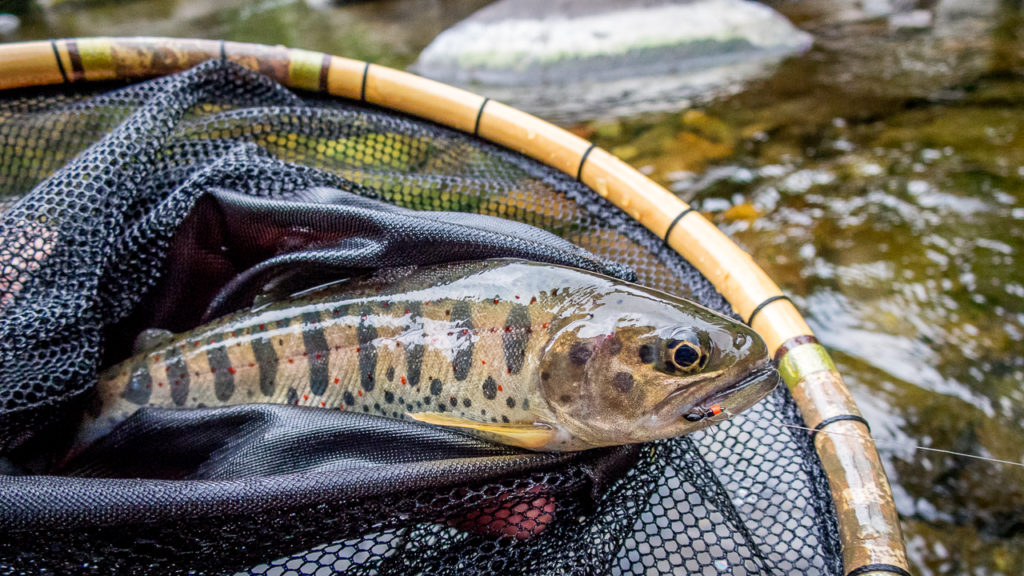Fly manipulation tactics for tenkara: Ashtapa-zuri (or “Pon Pon” as the onomatopoeia version would have it)…
CLICK HERE TO LEARN THE HYPNOTIC ASHTAPAZURI PRESENTATION TECHNIQUE
Have you tried it yet? The fly manipulation tactic from last week’s blog has been responsible for a ton of fish for readers (and writers!) of this blog in the last 7 days. We’ve had some good questions too. One in particular that means that we need to come clean on something.
Exactly where we got the name (and the part played by the excellent Asahi beer)?

If you’re a subscriber to the free tenkara fly fishing email lessons (Click here to sign up if not), then you might already know some names of many Japanese fly manipulation tactics. Tactics like Tome-zuri, Yokobiki/Ogibiki, Hashirakashi and all the rest will eventually become a lot more familiar to you than most fly fishers.
For this post, all you need to know is that the “zuri” (or “tsuri”) in “Tome-zuri” means “fishing”.
Here is why that matters. When me and John stumbled on how effective that little “finger-tapping” dodge was for surface flies – let’s just say we began to fully realise that there was a reason we’d see all those those top Japanese anglers doing it!
The thing is, we only had the good fortune to recognise what we were seeing because we’d used a version of it as part of our Euro-nymph fishing in the past. Pure chance. And because it was just something we observed, we hadn’t heard a name for the tactic…
…but we started catching so many fish by using it that we needed some way to reply when we hollered at each other from way downriver “What did you get that last fish on?”.
Anyway, one of the greatest things about the Japanese tenkara culture (and the merry band of people who make it awesome), is the BIG importance placed on the post-game BBQ and Beer gatherings. With a belly full of world-beating food (some gathered from the streamside that day) and some excellent beer from the ice-bucket – conversation comes easily and happily. The thrills and spills of the previous day on stream just flow out and there is a lot of laughter.
It was while I was talking to John with some enthusiasm about the successful manipulations we’d found that I was thinking out loud about the best way to describe what we’d been doing:
“The grip looks just like when someone holds a cigarette and is tapping the ash off the end of it”
So John replies straight away “Yeah – they should really call it ‘Ash-Tapper-Zuri’. Ha ha – ash-tapper fishing!”. Well, it made us chuckle anyway (premium Japanese beer is REALLY good).
It seemed like the perfect joke was also the perfect description of how to hold your hand to make the technique work really well.
Of course, the next time we were out on stream and either of us caught some fish on the technique – the reply to “What did you get those one?” just had to be “Ashtapazuri”. If you really wanted to take things too far, it is technically possible to spell the syllables using the Japanese Katakana symbols for the sounds A shi ta pa zu ri.
One thing I do need to be clear on is that, while we came up with the NAME as a joke, the tactic itself we learned is stone-cold legitimate because we saw top Japanese anglers doing it with such great success. After we fell into using it a lot ourselves, it seemed too good to not share with everyone.
You can understand how pleased we are that it is working for you too! We’ve heard great stories of your successes with the tactic so far and we’d really love to receive some photos from you to go with those.
Feel free to email them to me on paul@fishingdiscoveries.com and, when I get chance I will post them up on our Facebook page – we are keen to swap stories from all corners of the globe in exchange for what is going on in our little islands).
To get you started the photo in this blog is of a strikingly-coloured amago caught in Itoshiro using Ashtapazuri and Uberto Calligarich’s “ari-kebari” (ant fly) that he was so generous to give me as a gift.
Paul
PS If you want to get in on the free tutorials – Just Click Here (you can unsubscribe at any time with one click and we NEVER share your details)

Oh my. I pondered what the name Ashtapa-zuri might mean. (I think you know I wonder about the story behind names) The zuri part I got right off. The Ashtapa part remained a mystery. After reading the explanation I feel like I was looking at one of those optical illusion drawings but couldn’t see the second image until I was given a nudge to switch my perception. I like it. The anti-smoking zealots may not. Good story Paul & John.
Thanks David, it is pretty strange the way these things come about but it made us smile so we hoped we could share some of that fun around.